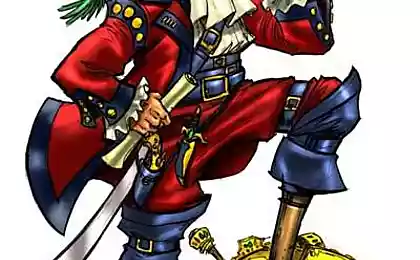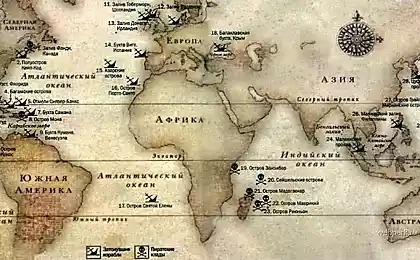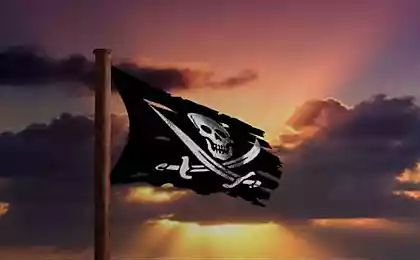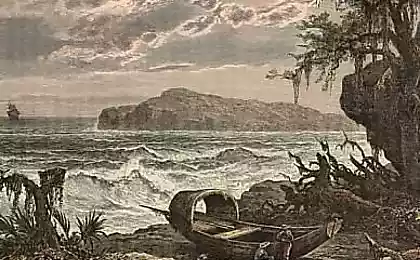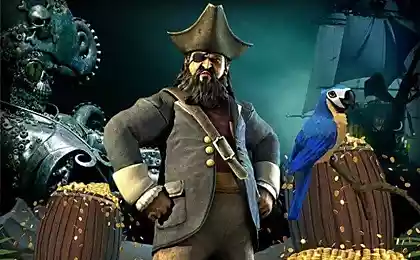1667
Pirates of the West Indies and the Indian Ocean
In this article, readers' attention is invited to the material, which reveals some interesting details of the phenomenon of human history as the "golden age" of piracy.
21 picture + text source.
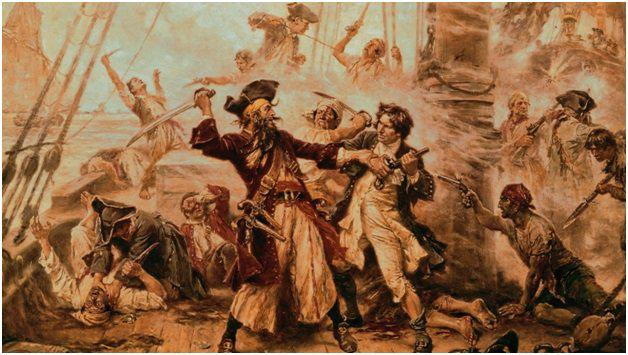
Rest we can only dream
How long the pirates managed to evade justice? How long to continue their career? And often if they could, filling the years of sea robbery treasure chests to retire? To answer these questions, you can bring some interesting moments biographies of the twelve most famous pirates of the "Golden Age" of piracy (in the broad sense), which lasted for about seventy years. Conditional date it can be considered the beginning of the 1655, when the British captured Jamaica (which allowed the pirates settled in Port Royal, Tortuga earlier on), and the end date in 1730 when piracy in the Caribbean and Atlantic (and even earlier in the Indian Ocean) it was finally liquidated.
Tortuga Island in the figure. Citadel pirates of the Caribbean from 1630's to nachalo1690-ies Map of the XVII century.
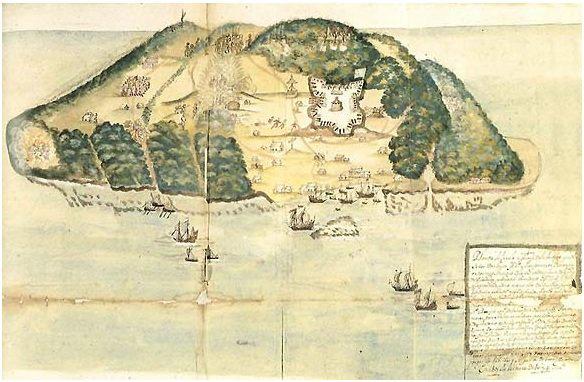
Edward Mansfield - was a privateer (received a patent from the governor of Jamaica) in the West Indies since the beginning of 1660 up to 1666 headed the pirate fleet. He died in 1666 of a sudden illness at the time of the attack on the island of Santa Catalina, and other sources was killed in an attack by the Spaniards in the way of help from Tortuga.
Francois L'Olone - was captain of a pirate in the West Indies. He plundered from 1653-1669 GG He died in 1669 in the Gulf of Darien, off the coast of Panama, during the Indian attack.
Henry Morgan - a pirate in the West Indies with the 50-ies XVII., And from 1667-1671 GG privateer (received a patent from the governor of Jamaica). He was the leader of the pirate fleet and even received the unofficial title of "Admiral of pirates." He died of natural causes in 1688 (presumably from cirrhosis of the liver due to excessive consumption of rum) in Port Royal, Jamaica.
Thomas Tew - a few years (presumably 1690) was a pirate in the West Indies, and from 1692-1695 GG privateer (received a patent from the Governor of Bermuda). It is considered a pioneer of pirate circle. He was captain of a pirate in the Indian Ocean. He died in the Red Sea near Bab el-Mandeb Strait in September 1695 in an attack on a merchant ship, "the Prophet Mohammed." Tew suffered a horrible death: it has got a cannon ball.
the figure Pirate Round. This route swam the English pirates of the West Indies and the Atlantic since the end of the XVII century. and prior to 1720 GG
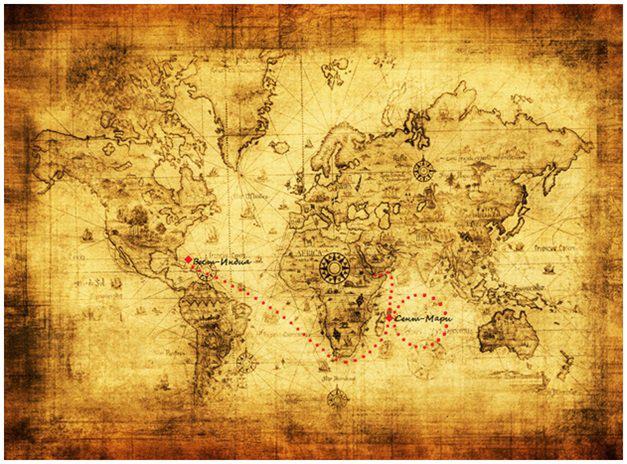
Henry Avery, nicknamed "Long Ben" - from 1694-1696 GG He was the captain of the pirates in the Indian Ocean. After the capture in the Red Sea in 1695 the trading ship "Gansvey" sailed back to the West Indies. Then he appeared in Boston, and then disappeared. Over his head was a reward of 500 pounds, but find Avery did not succeed. According to some rumors he moved to Ireland, on the other in Scotland.
William Kidd - since 1688, was filibusters and then privateer in the West Indies (received a patent from the governor of Martinique). Defected to the British, and for some time to retire. In 1695, he was hired by the influential people of New England to catch pirates, including Thomas Tew, also received a patent for privatirsky robbery of ships under the French flag. However, because of the riot broke out was forced to do filibuster that lasted from 1697-1699 gg
Voluntarily surrendered to justice. Hanged (with the room in an iron cage) May 23, 1701 by a court decision in London for the murder of a sailor, William Moore and the attack on a merchant ship "Kedahsky merchant».
Edward Teach, known as "Blackbeard" - since 1713, he was an ordinary pirate Captain Benjamin Hornigold and from 1716-1718 GG he was captain of the pirates, wielded in the Caribbean and Atlantic. He was killed in a battle with Lieutenant Robert Maynard on the deck of the sloop "Jane" November 22, 1718 Okrakouk Island, off the coast of North Carolina.
Quest in the figure on the deck of the sloop "Jane." At the heart of Robert Maynard and Blackbeard. Painting beginning of XX v.Shvatka deck of the sloop "Jane." At the heart of Robert Maynard and Blackbeard. Painting beginning of XX century.

Semmyuel Bellamy - was captain of the pirates in the Caribbean Sea and the Atlantic Ocean to the 1715-1717 GG It sank during a storm on 26-27 April 1717 on the ship "Vaida" along with most of the team off the coast of Massachusetts near Cape Cape Cod.
Edward England - was a pirate in the Caribbean since 1717, and since 1718-1720 GG the captain of the pirates in the Indian Ocean. There was a rebellious crew landed on one of the uninhabited islands in the Indian Ocean. He was able to return to Madagascar, where he was forced to go begging. He died there in 1721, in absolute poverty.
Stede Bonnet - was the captain of the pirates in the Caribbean Sea and the Atlantic Ocean to the 1717-1718 GG Hanged by the verdict of the court December 10, 1718 in Charleston, North Carolina, for piracy.
John Rackham, known as "Calico Jack" - a few years he was a smuggler, and a 1718 pirate captain in the Caribbean. In 1719, he was pardoned by the governor of New Providence Woods Rogers. However, already in 1720 he took up the old one. Hanged (with the room in an iron cage) upon conviction by November 17, 1720 in Spanish Town, Jamaica, for piracy.
Bartholomew Roberts, nicknamed "Black Bart" - was the captain of the pirates in the Caribbean Sea and the Atlantic Ocean to the 1719-1722 GG He died February 10, 1722 by a volley of buckshot hit the western coast of Central Africa, in the Cape Lopez, the attack of the English royal warship "Swallow».
As you can see, the life of pirates, even such notorious thugs, most of them were short-lived. Any person who has decided to link their lives with a filibuster in those hard times, almost certainly waited for death. And those lucky ones who managed to survive, lived on in misery and fear for their lives. Of those famous pirates only Morgan (and possibly Avery) finished his life a free and wealthy man. Only a very few pirates managed to amass a fortune and retire. Almost all waiting for the gallows, death in battle or deep sea.
Hanging in the figure Stede Bonnet December 10, 1718 A bouquet of flowers in his hands means that the condemned men repented of the crime. Engraving the beginning of the XVIII century.
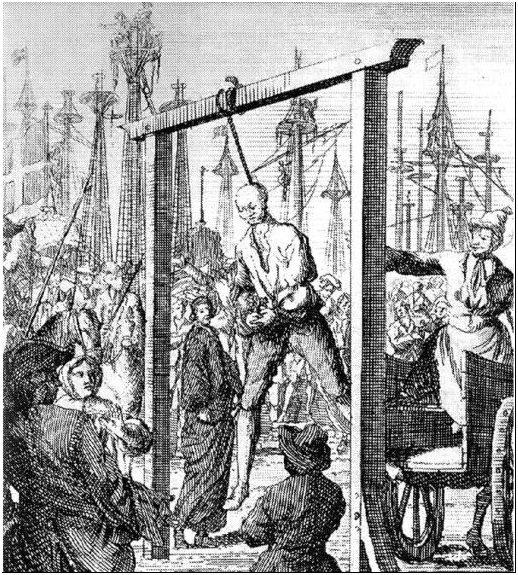
As the pirates looked
Literature and cinema created in the minds of most people, the classic image of a pirate with bandanna-bandana on his head, ear ring and a black patch over one eye. In fact, these pirates look quite different. In real life, they are dressed in the same way as ordinary seamen of his time. They did not have any of its, a specific garment.
Ekskvemelin, himself a former pirate with GG 1667-1672 and participate directly in the famous expedition of pirates led by Morgan to capture Panama (City), he wrote:
"After a bit, the pirates noticed Tower Panama, uttered three words spell and began throwing hats up in advance already celebrating victory».
Filibusters seized in the Spanish city. The engraving of the XVII century.
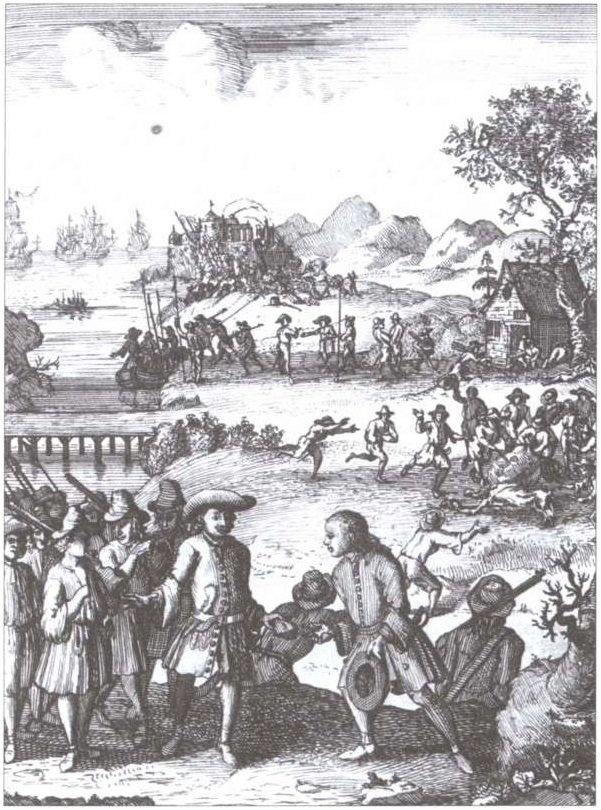
In his book "The Pirates of America" in 1678 Ekskvemelin never mentions that the pirates wore scarves on their heads. It is logical that in the tropical heat and the scorching sun, which are common in the Caribbean most of the year, wide-brimmed hats were given good protection from the sun's rays. Even in the rainy season they helped not get wet to the skin.
Pirate captain Francois L'Olone and Miguel Basque. The engraving of the XVII century.
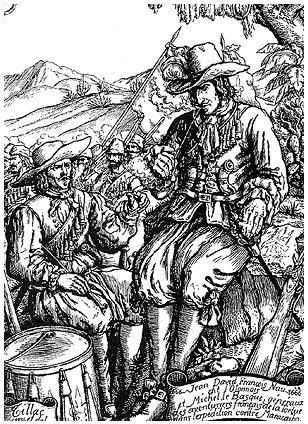
Do pirates wore wide-brimmed hats in the sea all the time? Probably not, because during the strong wind on the sea they would surely frustrated with the head. Since the 60-ies XVII. wide-brimmed hats begin quickly supplanted gained immense popularity cocked hat. It is in the cocked shown most pirates in old engravings late XVII-early XVIII century.
Henry Avery, nicknamed "Long Ben". Engraving the beginning of the XVIII century.
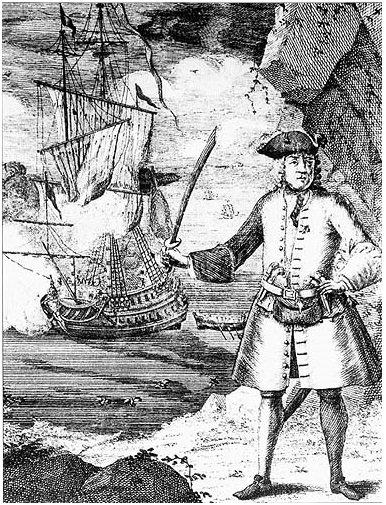
As a rule, the sailors in those days was one set of clothes in which they went up to its deterioration. Then buy a new suit. Besides, people hunted sea robbery, it has always been a good opportunity to select clothes from their victims on the captured ship, unless, of course, the pirates did not decide to declare all common prey captured and sold at auction in the port of its resellers. And the clothes, to the era of the emergence of mass production in the XIX century., Was expensive. Although sometimes pirates dressed like real dandies. Thus, the famous pirate beginning of the XVIII century. Bartholomew Roberts before the battle wore the bright red vest and pants, hat with a red feather and diamond cross on a gold chain.
Bartholomew Roberts, nicknamed "Black Bart". Engraving the beginning of the XVIII century.
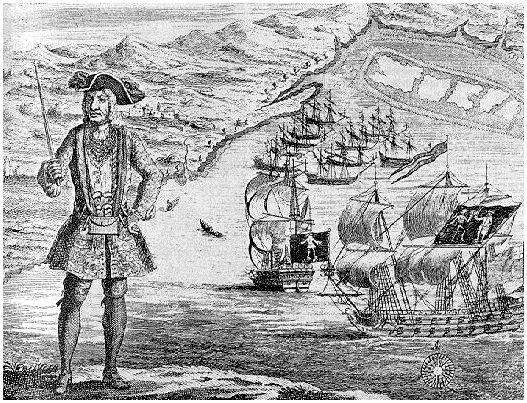
Judging by old engravings, many pirates wore a mustache, and sometimes a beard. For the pirate Edward Teach, his thick black beard and truly become an integral part of the image. Sometimes he weaves into her ribbon.
In addition, he placed under his hat cannon wicks that singeing before the battle, making the head pirate captain envelops a cloud of smoke, which gave him a sinister, diabolical kind.
Even Blackbeard wore crosswise over the suit, two broad sling with six loaded pistols. His appearance was really frightening, given the still marked contemporaries and well communicated old prints mad, wild look.
Edward Teach, known as "Blackbeard". Detail engraving beginning of the XVIII century.
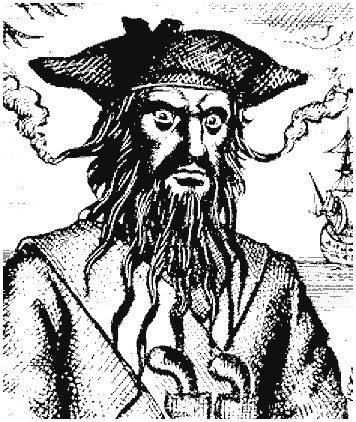
Virtually all engravings beginning of XVII-XVIII century. Pirates are depicted with long hair or wigs with fashionable then - rider. For example, Henry Morgan was thick and long hair, as adopted at the time fashion.
Portrait "Pirate Admiral" Henry Morgan. The engraving of the XVII century.
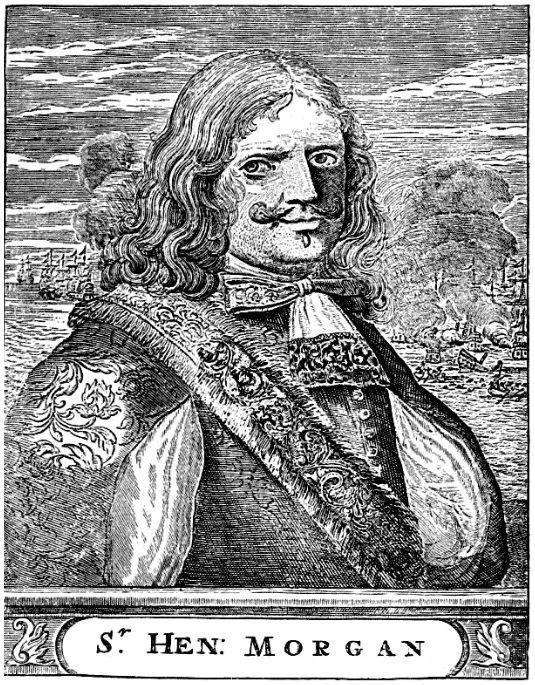
As for wigs, then this thing is impractical and unlikely to be worn while swimming. In addition, the wigs were expensive, were not affordable for most pirates, and most likely do not need them. Rather, a good wig was a status symbol, it could not afford leaders pirates (before selecting a wig from some nobleman or merchant ship robbery). Captains could wear a wig (with expensive suits) when went ashore in a large port to impress the gathered audience.
Edward England. Detail engraving beginning of the XVIII century.
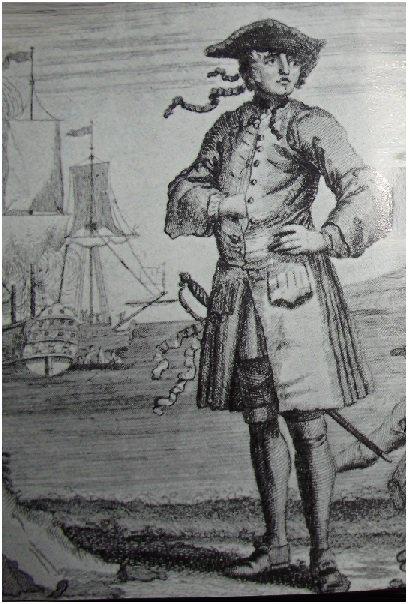
Like all seafarers XVII-XVIII centuries, the pirates of the West Indies and the Indian Ocean wore wide pants that reach just below the knee and tied with ribbons. Many wore culottes - the so-called "women's pants." They differed from the usual amount, because they were very large and more like a divided skirt female half. It is known that "women's pants" wore Edward Teach (in the picture presented in the first chapter, the artist depicted Blackbeard just in such "women's pants»).
Pirate end of XVII-beginning of the XVIII century. Clearly visible pants tied with a ribbon in the area of the knee. Figure XIX century.
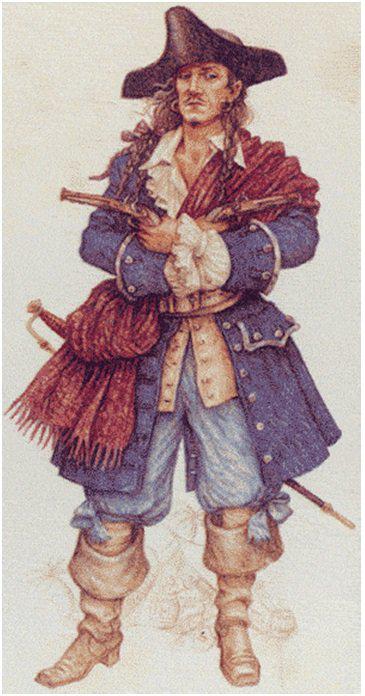
As for rings or other jewelry in the ears, in reality they were not pirates, or at least did not survive no historical evidence of such a custom. About them there is no mention in Ekskvemelin in "Pirates of America" in 1678, nor Charles Johnson in the "General History of looting and slaughter, uchinёnnyh most famous pirates" in 1724, nor other historical sources. In addition, almost all engravings ears pirates closed long hair or wigs for fashion then adopted. Although it should be mentioned that a century earlier (in the XVI century.) Men in Western Europe preferred short hair and wore earrings (not the ring). But since the beginning of the XVII century. in fashion long hair, and with them disappear and jewelry in the ears of men, which also contributed to the increasingly distributed in England and Holland puritanical views. In this hair in men was not made to pull into a bun on the nape. So do only if the wig is worn.
Portrait of the first leader of the filibusters of Jamaica, Christopher Cummings. The painting of the XVII century.
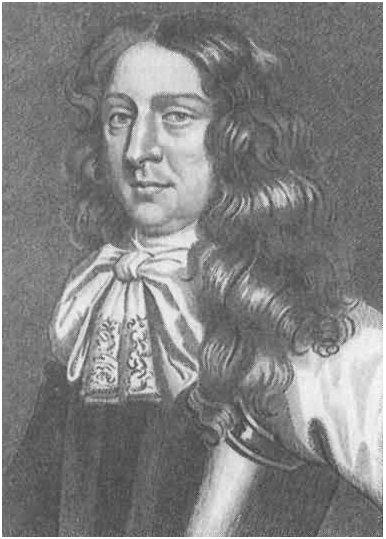
And why, he wondered, to wear rings in their ears, if by long hair or a wig they still nobody sees?
Incredibly stable turned the myth of pirates wearing black armbands to eye damage. There is no historical evidence that the pirates have damaged their eyes closed dressings. There are no written sources and etchings XVII-XVIII centuries describing or depicting pirates blindfolded.
In addition, there are some written sources that suggest just the opposite - that the pirates deliberately paraded their old wounds, to further intimidate the enemy.
The first black armbands appear in literature in the end of XIX century., First in the form of colorful illustrations in books about pirates (Howard Pyle is considered the first illustrator to depict pirates colorful bandana and earrings in the ear), and later already in novels about themselves pirates. From there they go to the cinema once and for all become an inherent part of the pirates.
John Rackham, known as "Calico Jack". Engraving the beginning of the XVIII century.
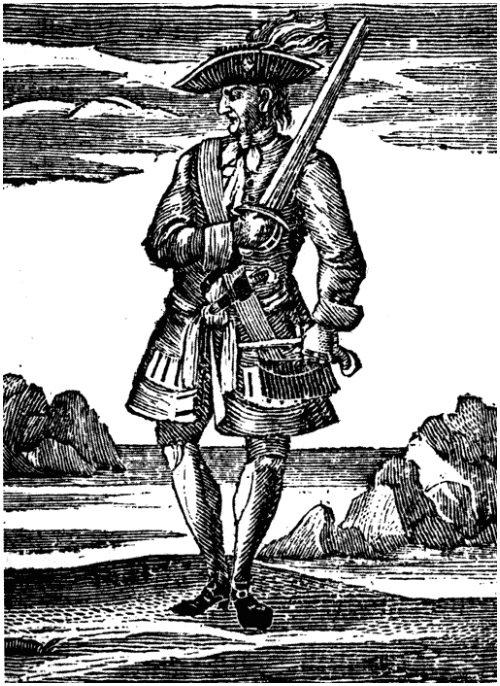
Spoils
Pirate laws spoils were very different and change over time. In the middle of the XVII century., When it was still common privateering (sea robbery issued on the basis of a State authorization - letters of marque, privatirskogo patent, commissions, retaliation, robbing ships and settlements of hostile countries), part of the booty, usually at least 10 percent, privateers (or privateers) gave the government their authorization to robbery. However, the authorities often share was much higher. Thus, in the first received Captain William Kidd on the authorities of New England privatirskom patent authorities to share in the production of the expedition was 60 percent, respectively, Kidd and commands 40. In the second, received in 1696, the share of government amounted to 55 percent, the share of Kidd and his companion Robert Livingston 20 percent, and the remaining quarter relied team members, which do not provide for any salary other than booty.
Privatirsky patent (original) issued by Captain William Kidd in 1696
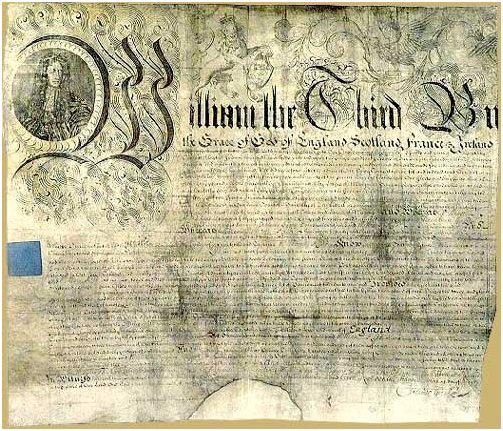
Of the remaining part of the production gave the suppliers of food, weapons accessories, Roma and other necessary equipment (if you take a loan). Finally, the part of production that remained with the pirates after these calculations (sometimes quite a bit), they are divided among themselves. Captains received more usually five or six shares.
With the disappearance of privateering in the end the beginning of the XVII-XVIII century. any payments to the Government of the pirates have not already done. Although there have been exceptions. So, Blackbeard bribed officials in the ports, which provide him with information on cargo and route of merchant ships. Other captains just gave expensive gifts to the governors of the colonies of the loot (in other words, bribes), for overall protection.
In addition, these masters provide the governors of the colonies of friendly intelligence information about the state of affairs in the territory of the enemy, and the movement of his fleet.
In 1694, Thomas Tew (left) presented the New York Governor Benjamin Fletcher (right), precious stones, seized in the Red Sea. Figure XIX century.
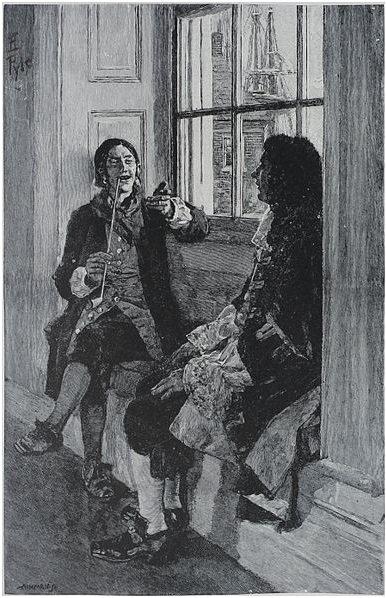
Gradually spoils becoming more democratic. At the beginning of the XVIII century. Capital has become a generally no more than two - three shares, and officers, and even less.
This is how the distribution of the spoils of the expedition led by the pirate Henry Morgan in Panama in 1671 Ekskvemelin himself participated in this campaign:
"Citing the case in the final order, he (Morgan - approx.'s) Called all the officers and captains of the fleet, to agree how much they should receive for their services. The officers got together and decided that Morgan should be for special assignments hundred people; This was communicated to all the ordinary, and they have expressed their consent. It was agreed that each ship must have its captain; Then came all the lower officers and boatswains lieutenants - and decided that the captain be issued eight stakes and beyond if it is different; the surgeon must be given two hundred reais in its pharmacy and one share; carpenters - a hundred and one reais a share. In addition, the share has been set for the most distinguished and affected by the enemy, as well as for those who hoisted the first flag on the strengthening of the enemy and declare it in English; they decided that for this must be added another fifty reais. Anyone who will be exposed to great danger, received on its stake two hundred reais. Grenadiers, who bombarded the fortress grenades should receive five reais for each grenade.
Then it was found compensation for injury: whoever loses both hands must get over its share even fifteen hundred reals or fifteen slaves (optional affected); who lost both legs, should receive one thousand eight hundred eighteen reais, or slaves; who lost a hand, no matter the left or right, should get five hundred reais or five slaves. To lose a leg, no matter right or left, it was believed, five hundred reais or five slaves. For the loss of the eye was supposed hundred reais or a slave.
21 picture + text source.

Rest we can only dream
How long the pirates managed to evade justice? How long to continue their career? And often if they could, filling the years of sea robbery treasure chests to retire? To answer these questions, you can bring some interesting moments biographies of the twelve most famous pirates of the "Golden Age" of piracy (in the broad sense), which lasted for about seventy years. Conditional date it can be considered the beginning of the 1655, when the British captured Jamaica (which allowed the pirates settled in Port Royal, Tortuga earlier on), and the end date in 1730 when piracy in the Caribbean and Atlantic (and even earlier in the Indian Ocean) it was finally liquidated.
Tortuga Island in the figure. Citadel pirates of the Caribbean from 1630's to nachalo1690-ies Map of the XVII century.

Edward Mansfield - was a privateer (received a patent from the governor of Jamaica) in the West Indies since the beginning of 1660 up to 1666 headed the pirate fleet. He died in 1666 of a sudden illness at the time of the attack on the island of Santa Catalina, and other sources was killed in an attack by the Spaniards in the way of help from Tortuga.
Francois L'Olone - was captain of a pirate in the West Indies. He plundered from 1653-1669 GG He died in 1669 in the Gulf of Darien, off the coast of Panama, during the Indian attack.
Henry Morgan - a pirate in the West Indies with the 50-ies XVII., And from 1667-1671 GG privateer (received a patent from the governor of Jamaica). He was the leader of the pirate fleet and even received the unofficial title of "Admiral of pirates." He died of natural causes in 1688 (presumably from cirrhosis of the liver due to excessive consumption of rum) in Port Royal, Jamaica.
Thomas Tew - a few years (presumably 1690) was a pirate in the West Indies, and from 1692-1695 GG privateer (received a patent from the Governor of Bermuda). It is considered a pioneer of pirate circle. He was captain of a pirate in the Indian Ocean. He died in the Red Sea near Bab el-Mandeb Strait in September 1695 in an attack on a merchant ship, "the Prophet Mohammed." Tew suffered a horrible death: it has got a cannon ball.
the figure Pirate Round. This route swam the English pirates of the West Indies and the Atlantic since the end of the XVII century. and prior to 1720 GG

Henry Avery, nicknamed "Long Ben" - from 1694-1696 GG He was the captain of the pirates in the Indian Ocean. After the capture in the Red Sea in 1695 the trading ship "Gansvey" sailed back to the West Indies. Then he appeared in Boston, and then disappeared. Over his head was a reward of 500 pounds, but find Avery did not succeed. According to some rumors he moved to Ireland, on the other in Scotland.
William Kidd - since 1688, was filibusters and then privateer in the West Indies (received a patent from the governor of Martinique). Defected to the British, and for some time to retire. In 1695, he was hired by the influential people of New England to catch pirates, including Thomas Tew, also received a patent for privatirsky robbery of ships under the French flag. However, because of the riot broke out was forced to do filibuster that lasted from 1697-1699 gg
Voluntarily surrendered to justice. Hanged (with the room in an iron cage) May 23, 1701 by a court decision in London for the murder of a sailor, William Moore and the attack on a merchant ship "Kedahsky merchant».
Edward Teach, known as "Blackbeard" - since 1713, he was an ordinary pirate Captain Benjamin Hornigold and from 1716-1718 GG he was captain of the pirates, wielded in the Caribbean and Atlantic. He was killed in a battle with Lieutenant Robert Maynard on the deck of the sloop "Jane" November 22, 1718 Okrakouk Island, off the coast of North Carolina.
Quest in the figure on the deck of the sloop "Jane." At the heart of Robert Maynard and Blackbeard. Painting beginning of XX v.Shvatka deck of the sloop "Jane." At the heart of Robert Maynard and Blackbeard. Painting beginning of XX century.

Semmyuel Bellamy - was captain of the pirates in the Caribbean Sea and the Atlantic Ocean to the 1715-1717 GG It sank during a storm on 26-27 April 1717 on the ship "Vaida" along with most of the team off the coast of Massachusetts near Cape Cape Cod.
Edward England - was a pirate in the Caribbean since 1717, and since 1718-1720 GG the captain of the pirates in the Indian Ocean. There was a rebellious crew landed on one of the uninhabited islands in the Indian Ocean. He was able to return to Madagascar, where he was forced to go begging. He died there in 1721, in absolute poverty.
Stede Bonnet - was the captain of the pirates in the Caribbean Sea and the Atlantic Ocean to the 1717-1718 GG Hanged by the verdict of the court December 10, 1718 in Charleston, North Carolina, for piracy.
John Rackham, known as "Calico Jack" - a few years he was a smuggler, and a 1718 pirate captain in the Caribbean. In 1719, he was pardoned by the governor of New Providence Woods Rogers. However, already in 1720 he took up the old one. Hanged (with the room in an iron cage) upon conviction by November 17, 1720 in Spanish Town, Jamaica, for piracy.
Bartholomew Roberts, nicknamed "Black Bart" - was the captain of the pirates in the Caribbean Sea and the Atlantic Ocean to the 1719-1722 GG He died February 10, 1722 by a volley of buckshot hit the western coast of Central Africa, in the Cape Lopez, the attack of the English royal warship "Swallow».
As you can see, the life of pirates, even such notorious thugs, most of them were short-lived. Any person who has decided to link their lives with a filibuster in those hard times, almost certainly waited for death. And those lucky ones who managed to survive, lived on in misery and fear for their lives. Of those famous pirates only Morgan (and possibly Avery) finished his life a free and wealthy man. Only a very few pirates managed to amass a fortune and retire. Almost all waiting for the gallows, death in battle or deep sea.
Hanging in the figure Stede Bonnet December 10, 1718 A bouquet of flowers in his hands means that the condemned men repented of the crime. Engraving the beginning of the XVIII century.

As the pirates looked
Literature and cinema created in the minds of most people, the classic image of a pirate with bandanna-bandana on his head, ear ring and a black patch over one eye. In fact, these pirates look quite different. In real life, they are dressed in the same way as ordinary seamen of his time. They did not have any of its, a specific garment.
Ekskvemelin, himself a former pirate with GG 1667-1672 and participate directly in the famous expedition of pirates led by Morgan to capture Panama (City), he wrote:
"After a bit, the pirates noticed Tower Panama, uttered three words spell and began throwing hats up in advance already celebrating victory».
Filibusters seized in the Spanish city. The engraving of the XVII century.

In his book "The Pirates of America" in 1678 Ekskvemelin never mentions that the pirates wore scarves on their heads. It is logical that in the tropical heat and the scorching sun, which are common in the Caribbean most of the year, wide-brimmed hats were given good protection from the sun's rays. Even in the rainy season they helped not get wet to the skin.
Pirate captain Francois L'Olone and Miguel Basque. The engraving of the XVII century.

Do pirates wore wide-brimmed hats in the sea all the time? Probably not, because during the strong wind on the sea they would surely frustrated with the head. Since the 60-ies XVII. wide-brimmed hats begin quickly supplanted gained immense popularity cocked hat. It is in the cocked shown most pirates in old engravings late XVII-early XVIII century.
Henry Avery, nicknamed "Long Ben". Engraving the beginning of the XVIII century.

As a rule, the sailors in those days was one set of clothes in which they went up to its deterioration. Then buy a new suit. Besides, people hunted sea robbery, it has always been a good opportunity to select clothes from their victims on the captured ship, unless, of course, the pirates did not decide to declare all common prey captured and sold at auction in the port of its resellers. And the clothes, to the era of the emergence of mass production in the XIX century., Was expensive. Although sometimes pirates dressed like real dandies. Thus, the famous pirate beginning of the XVIII century. Bartholomew Roberts before the battle wore the bright red vest and pants, hat with a red feather and diamond cross on a gold chain.
Bartholomew Roberts, nicknamed "Black Bart". Engraving the beginning of the XVIII century.

Judging by old engravings, many pirates wore a mustache, and sometimes a beard. For the pirate Edward Teach, his thick black beard and truly become an integral part of the image. Sometimes he weaves into her ribbon.
In addition, he placed under his hat cannon wicks that singeing before the battle, making the head pirate captain envelops a cloud of smoke, which gave him a sinister, diabolical kind.
Even Blackbeard wore crosswise over the suit, two broad sling with six loaded pistols. His appearance was really frightening, given the still marked contemporaries and well communicated old prints mad, wild look.
Edward Teach, known as "Blackbeard". Detail engraving beginning of the XVIII century.

Virtually all engravings beginning of XVII-XVIII century. Pirates are depicted with long hair or wigs with fashionable then - rider. For example, Henry Morgan was thick and long hair, as adopted at the time fashion.
Portrait "Pirate Admiral" Henry Morgan. The engraving of the XVII century.

As for wigs, then this thing is impractical and unlikely to be worn while swimming. In addition, the wigs were expensive, were not affordable for most pirates, and most likely do not need them. Rather, a good wig was a status symbol, it could not afford leaders pirates (before selecting a wig from some nobleman or merchant ship robbery). Captains could wear a wig (with expensive suits) when went ashore in a large port to impress the gathered audience.
Edward England. Detail engraving beginning of the XVIII century.

Like all seafarers XVII-XVIII centuries, the pirates of the West Indies and the Indian Ocean wore wide pants that reach just below the knee and tied with ribbons. Many wore culottes - the so-called "women's pants." They differed from the usual amount, because they were very large and more like a divided skirt female half. It is known that "women's pants" wore Edward Teach (in the picture presented in the first chapter, the artist depicted Blackbeard just in such "women's pants»).
Pirate end of XVII-beginning of the XVIII century. Clearly visible pants tied with a ribbon in the area of the knee. Figure XIX century.

As for rings or other jewelry in the ears, in reality they were not pirates, or at least did not survive no historical evidence of such a custom. About them there is no mention in Ekskvemelin in "Pirates of America" in 1678, nor Charles Johnson in the "General History of looting and slaughter, uchinёnnyh most famous pirates" in 1724, nor other historical sources. In addition, almost all engravings ears pirates closed long hair or wigs for fashion then adopted. Although it should be mentioned that a century earlier (in the XVI century.) Men in Western Europe preferred short hair and wore earrings (not the ring). But since the beginning of the XVII century. in fashion long hair, and with them disappear and jewelry in the ears of men, which also contributed to the increasingly distributed in England and Holland puritanical views. In this hair in men was not made to pull into a bun on the nape. So do only if the wig is worn.
Portrait of the first leader of the filibusters of Jamaica, Christopher Cummings. The painting of the XVII century.

And why, he wondered, to wear rings in their ears, if by long hair or a wig they still nobody sees?
Incredibly stable turned the myth of pirates wearing black armbands to eye damage. There is no historical evidence that the pirates have damaged their eyes closed dressings. There are no written sources and etchings XVII-XVIII centuries describing or depicting pirates blindfolded.
In addition, there are some written sources that suggest just the opposite - that the pirates deliberately paraded their old wounds, to further intimidate the enemy.
The first black armbands appear in literature in the end of XIX century., First in the form of colorful illustrations in books about pirates (Howard Pyle is considered the first illustrator to depict pirates colorful bandana and earrings in the ear), and later already in novels about themselves pirates. From there they go to the cinema once and for all become an inherent part of the pirates.
John Rackham, known as "Calico Jack". Engraving the beginning of the XVIII century.

Spoils
Pirate laws spoils were very different and change over time. In the middle of the XVII century., When it was still common privateering (sea robbery issued on the basis of a State authorization - letters of marque, privatirskogo patent, commissions, retaliation, robbing ships and settlements of hostile countries), part of the booty, usually at least 10 percent, privateers (or privateers) gave the government their authorization to robbery. However, the authorities often share was much higher. Thus, in the first received Captain William Kidd on the authorities of New England privatirskom patent authorities to share in the production of the expedition was 60 percent, respectively, Kidd and commands 40. In the second, received in 1696, the share of government amounted to 55 percent, the share of Kidd and his companion Robert Livingston 20 percent, and the remaining quarter relied team members, which do not provide for any salary other than booty.
Privatirsky patent (original) issued by Captain William Kidd in 1696

Of the remaining part of the production gave the suppliers of food, weapons accessories, Roma and other necessary equipment (if you take a loan). Finally, the part of production that remained with the pirates after these calculations (sometimes quite a bit), they are divided among themselves. Captains received more usually five or six shares.
With the disappearance of privateering in the end the beginning of the XVII-XVIII century. any payments to the Government of the pirates have not already done. Although there have been exceptions. So, Blackbeard bribed officials in the ports, which provide him with information on cargo and route of merchant ships. Other captains just gave expensive gifts to the governors of the colonies of the loot (in other words, bribes), for overall protection.
In addition, these masters provide the governors of the colonies of friendly intelligence information about the state of affairs in the territory of the enemy, and the movement of his fleet.
In 1694, Thomas Tew (left) presented the New York Governor Benjamin Fletcher (right), precious stones, seized in the Red Sea. Figure XIX century.

Gradually spoils becoming more democratic. At the beginning of the XVIII century. Capital has become a generally no more than two - three shares, and officers, and even less.
This is how the distribution of the spoils of the expedition led by the pirate Henry Morgan in Panama in 1671 Ekskvemelin himself participated in this campaign:
"Citing the case in the final order, he (Morgan - approx.'s) Called all the officers and captains of the fleet, to agree how much they should receive for their services. The officers got together and decided that Morgan should be for special assignments hundred people; This was communicated to all the ordinary, and they have expressed their consent. It was agreed that each ship must have its captain; Then came all the lower officers and boatswains lieutenants - and decided that the captain be issued eight stakes and beyond if it is different; the surgeon must be given two hundred reais in its pharmacy and one share; carpenters - a hundred and one reais a share. In addition, the share has been set for the most distinguished and affected by the enemy, as well as for those who hoisted the first flag on the strengthening of the enemy and declare it in English; they decided that for this must be added another fifty reais. Anyone who will be exposed to great danger, received on its stake two hundred reais. Grenadiers, who bombarded the fortress grenades should receive five reais for each grenade.
Then it was found compensation for injury: whoever loses both hands must get over its share even fifteen hundred reals or fifteen slaves (optional affected); who lost both legs, should receive one thousand eight hundred eighteen reais, or slaves; who lost a hand, no matter the left or right, should get five hundred reais or five slaves. To lose a leg, no matter right or left, it was believed, five hundred reais or five slaves. For the loss of the eye was supposed hundred reais or a slave.
